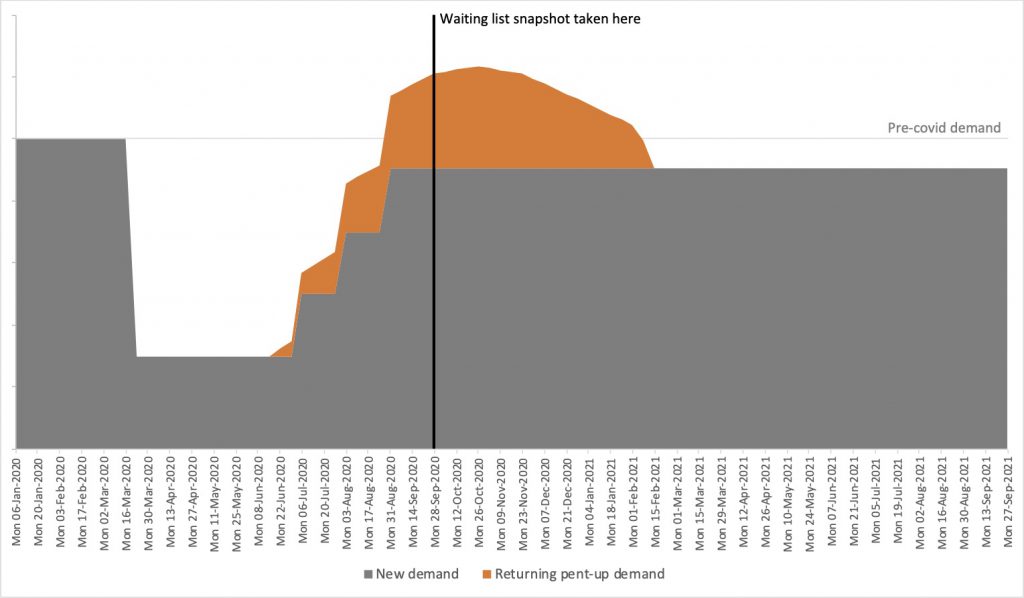
Covid-19 planning – phase 3 and beyond
16/09/2020by Rob Findlay
Planning in the NHS at the moment is all about activity and capacity.
Everyone is keen to get the NHS back to business, but covid is making it complicated because of social distancing, self-isolation, PPE, aerosols, and cleaning. So when it comes to planning, attention is understandably focused on doing as much elective activity as possible in these difficult times.
This won’t last.
Proper planning is about much more than activity and capacity. The clue is in the usual name for this task: demand and capacity planning. If we lose sight of demand, then ultimately we lose sight of everything. Things like: what will happen to the waiting list and waiting times? what should our core capacity be? how much activity is ‘enough’?
But even those questions only scratch the surface, because demand is literally fundamental. Demand is the work we have to do.
In the long run, activity must be enough to keep up with demand. There is no alternative. We cannot stay ahead of demand, because we would run out of waiting list. And we cannot keep falling behind demand either, because the waiting list and waiting times would eventually grow to politically unacceptable levels.
We can choose to keep up with demand while maintaining short waiting times, or while maintaining long waiting times, or we can cycle between the two, but either way we can do no more – and no less – than keep up with demand.
Demand and capacity planning under covid
Unfortunately demand is currently highly uncertain under covid. (This is another reason why everyone is focusing on activity – at least we can quantify that.) But this uncertainty has a silver lining, because it allows us to be fairly broad-brush about our scenarios.
For instance, the chart below illustrates a possible scenario for demand, across this year and next.

Pretend that today is the end of September 2020, where the vertical black line is. In this scenario we are guessing that new demand will continue into the future at a reduced rate of about 90% of pre-covid levels (the exact level, and for how long, are anybody’s guess). That demand is shown by the grey area.
We also expect that some of the missing demand from the depths of shutdown will bounce back at some point, but not all of it, and only after a delay (again, how much and how long is anybody’s guess). A scenario for this returning pent-up demand is shown by the orange area, which sits on top of the new demand.
Uncertainty into simplicity
So that’s a lot of pretty big guesses. The upside is that we can turn this uncertainty to our advantage by making simplifying assumptions. For instance, we might assume that the reduced rate of new demand exactly cancels out the returning pent-up demand over the coming year (which is the scenario shown in the above chart).
Now we can model this scenario very simply in Gooroo Planner, because:
- we can use pre-covid demand as a proxy for overall future demand, because our two big assumptions cancel each other out (so in Gooroo Planner we set the past period to end before the covid shutdown, so that pre-covid data is used to calculate demand);
- we can set the date when we think those assumptions will start to cancel out, by setting the future period to start on that date and loading a recent waiting list snapshot for it; and
- we can set future activity at whatever level we think we can deliver under covid (using the FutActiv field), which is the work the NHS has already been focusing on.
In short, this is an absolutely standard Gooroo Planner model, without any adjustments needed. The past period is pre-covid and the future period starts recently and runs to a date sometime next year, but otherwise this is fed from the usual SQL queries.
When we run that through, Gooroo Planner will tell us lots of useful things:
- what the waiting list would look like at the end (and this waiting list can be rolled forward to become the starting position for our subsequent recovery plan);
- what the sustainable waiting time would be then (and whether that breaches our targets);
- a cross-check of the capacity needed to deliver our activity plan, under the covid-restricted performance assumptions of our choice.
Refining the model
What if we want to refine our guesses? There are several ways of doing it, and this is where some assumptions need to be applied to each service.
We could change the start and end dates of the future period, to adjust the period over which we think the reduced new demand will balance the returning pent-up demand.
We could adjust the level of reduced new demand, to deviate from the assumption that it is balanced by the returning pent-up demand. In Gooroo Planner, we can do this using the statistical data field FutExtraDem (the amount of ‘extra’ demand we want in the future period, which can be negative). This can be done by downloading a report from the Report Manager, and using it to create a statistical dataset file containing FutExtraDem, calculated as (say) -5% of future demand (taken from the ResDemand field), which will deduct 5% from future demand compared with pre-covid levels.
Or we could adjust the level of returning pent-up demand, by making a further adjustment to FutExtraDem. All our assumptions about adjusting demand in the future period can be rolled up, in service-by-service detail, into this flexible field.
(You can also find a more general discussion of modelling covid in Gooroo Planner here.)
Keeping it simple
These simplifying assumptions mean we will lose some information about the exact trajectory we can expect to see week by week in the middle of this future period. It is of course possible to make assumptions about the timings of everything, and use Gooroo Planner to model the intervening period explicitly, but there is a judgement to be made about whether the effort would be worthwhile.
My suggestion is probably not: the most valuable output is the size of each waiting list when this covid period is over, because that is the starting point for the subsequent recovery plan. If we try to be too precise about the timings, across the scores or even hundreds of clinical services in a typical hospital-wide or system-wide planning model, there is a risk of getting lost in the complexity of the scenario we are trying to create and failing to complete the task at all.
Fully supported
Those of you who are masters of Gooroo Planner will have nodded through all that, however if you are not yet at that level then you may be feeling a bit mystified. Don’t worry – that is why Gooroo Planner comes with unlimited remote support. Please ask if you need a bit of help doing this – it’s all part of the service.
Return to Post Index
Leave a Reply
You must be logged in to post a comment.